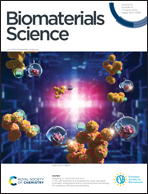Structure and properties of nanoparticles: DES-lignin-g-PNVCL coated aspirin by self-assembly†
Abstract
This work was carried out in order to broaden the application field of lignin and improve its additional value. The degraded deep eutectic solvent lignin-grafted poly(N-vinyl caprolactam) (DES-lignin-g-PNVCL) was synthesized by using modified DES-lignin and NVCL via activators regenerated by electron transfer-atom transfer radical polymerization (ARGET-ATRP). Aspirin was coated with DES-lignin-g-PNVCL through self-assembly by an ethanol/water anti-solvent method to obtain lignin thermosensitive polymer nanoparticle coated aspirin (aspirin@LTNP). X-ray electron spectroscopy (XPS), elemental analysis, scanning electron microscopy (SEM), transmission electron microscopy (TEM), Fourier transform infrared spectroscopy (FT-IR), dynamic light scattering (DLS), and ultraviolet visible spectroscopy (UV) were used to characterize the composition, structure and morphology of DES-lignin-g-PNVCL and aspirin@LTNP. The releasing behavior of aspirin@LTNP at different temperatures and pH values was investigated. The safety was evaluated by cytotoxicity tests. The results indicated that aspirin@LTNP was mainly accumulated by the hydrophobic effect and π–π interaction in the process of self-assembly, and its morphology was an ellipsoid stacked layer by layer. The aspirin@LTNP hydrophilic chains were increased and had externally hydrophilic and internally hydrophobic structures. The particle size decreased slightly during the self-assembly process. The red-shift occurred at the π–π interaction wavelength of the lignin aromatic ring, which indicated a physical coating process. The coating rate of aspirin@LTNP was 88.87%. Aspirin@LTNP showed an obvious temperature response; the 96 h cumulative release rate at the LCST was 73.75 ± 1.16%, while the 96 h cumulative release rate above the LCST was 28.10 ± 0.92%. The 96 h cumulative release rate was 63.21 ± 0.57% at pH = 1.5 and 49.56 ± 0.48% at pH = 7.4. The dosage of aspirin@LTNP used in the experiment was safe. This study provided a strategy for drug coating and controlled release.



 Please wait while we load your content...
Please wait while we load your content...